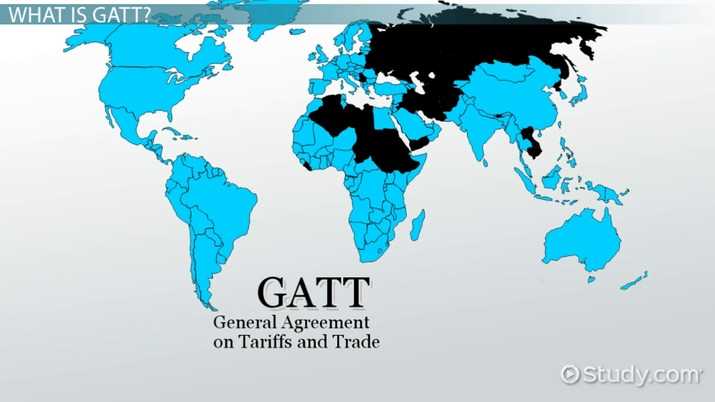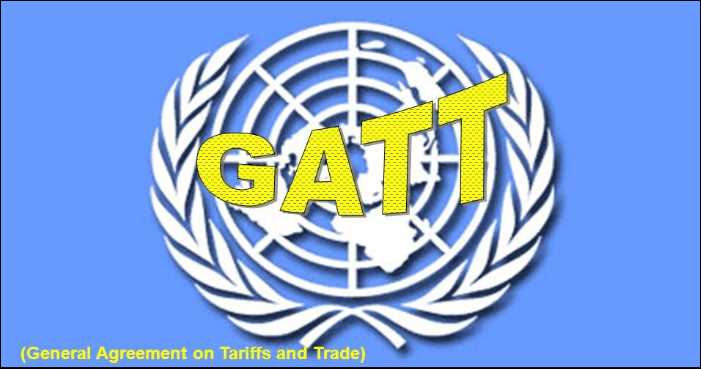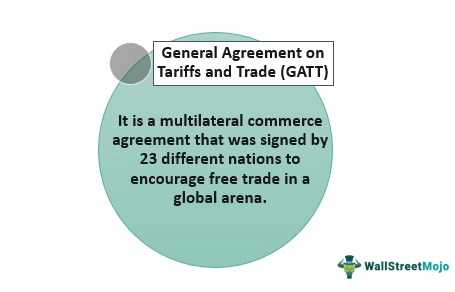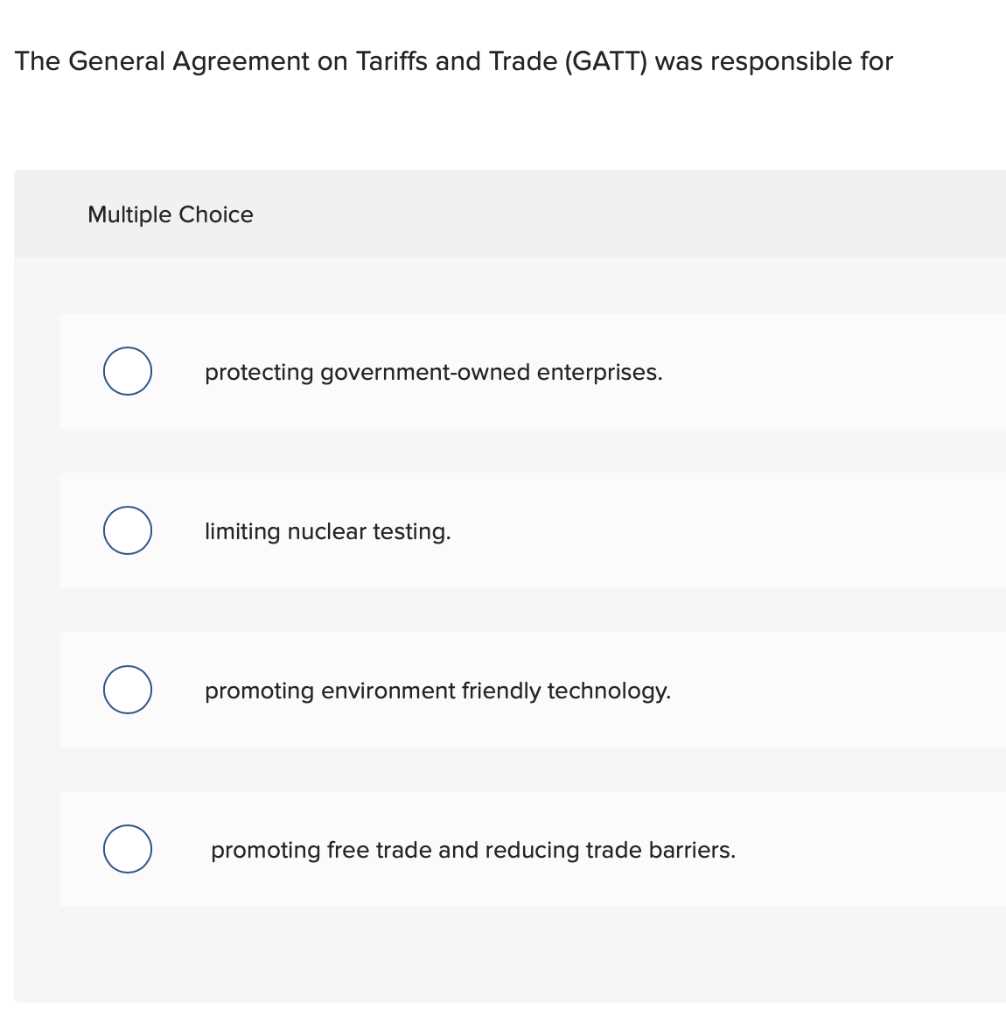The General Agreement on Tariffs and Trade (GATT): A Comprehensive Overview
The General Agreement on Tariffs and Trade (GATT) is an international treaty that was established in 1947 with the aim of promoting international trade and reducing trade barriers between member countries. It served as a framework for negotiations and agreements on trade policies, and played a crucial role in the post-World War II economic recovery.
GATT was based on the principles of non-discrimination, reciprocity, and transparency. It aimed to eliminate discriminatory treatment between member countries and promote fair and open trade. Under GATT, member countries agreed to reduce tariffs and other trade barriers through a process of negotiations and concessions.
The key objective of GATT was to promote economic growth and development by fostering international trade. It sought to achieve this by reducing tariffs, eliminating quantitative restrictions, and ensuring non-discriminatory treatment of goods and services. GATT also provided a platform for resolving trade disputes through its dispute settlement mechanism.
GATT had several key provisions and rules that governed international trade. These included the most-favored-nation (MFN) principle, which required member countries to extend any favorable trade treatment to all other member countries. GATT also prohibited the use of quantitative restrictions, such as import quotas and export subsidies, except under certain specified circumstances.
The impact and significance of GATT cannot be overstated. It played a crucial role in promoting global economic integration and reducing trade barriers. GATT contributed to the expansion of international trade and the growth of the global economy. It provided a stable and predictable framework for trade relations between member countries, which helped to boost investor confidence and stimulate economic growth.
Over time, GATT evolved into the World Trade Organization (WTO) in 1995. The WTO built upon the principles and rules established by GATT and expanded its scope to cover services, intellectual property, and other areas of trade. The WTO continues to play a vital role in promoting international trade and resolving trade disputes among its member countries.
| Key Points | Details |
|---|---|
| Established | 1947 |
| Principles | Non-discrimination, reciprocity, transparency |
| Objectives | Promote international trade, reduce trade barriers |
| Provisions | MFN principle, prohibition of quantitative restrictions |
| Impact | Promoted global economic integration, stimulated economic growth |
| Evolution | Transformed into the World Trade Organization (WTO) in 1995 |
History and Background of GATT
The General Agreement on Tariffs and Trade (GATT) was established in 1947 as an international treaty aimed at promoting free trade and reducing trade barriers among its member countries. It was created in response to the economic devastation caused by World War II and the Great Depression, with the goal of fostering economic growth and stability through increased international trade.
GATT was initially signed by 23 countries, including the United States, United Kingdom, and Canada. Over the years, the number of member countries grew to 164 by the time GATT was replaced by the World Trade Organization (WTO) in 1995.
Principles of GATT
GATT was based on several key principles that guided its operations:
- Most-Favored-Nation (MFN) Treatment: Member countries were required to extend any favorable trade terms granted to one country to all other member countries, ensuring non-discrimination in trade.
- Reciprocity: GATT promoted the idea of reciprocal trade concessions, where countries would lower their trade barriers in exchange for similar concessions from other countries.
- Trade without Discrimination: GATT aimed to eliminate discriminatory practices, such as quotas and import restrictions, that hindered international trade.
- Transparency: GATT encouraged member countries to be transparent about their trade policies and regulations, promoting a more open and predictable trading system.
Evolution of GATT
The Uruguay Round expanded the scope of GATT to cover new areas such as services, intellectual property, and agriculture. It also established a more robust dispute settlement mechanism to enforce the rules and resolve trade disputes between member countries.
In 1995, GATT was replaced by the World Trade Organization, which incorporated the principles and rules of GATT into its framework. The WTO continues to promote free trade and resolve trade disputes among its member countries, building on the foundation laid by GATT.
The General Agreement on Tariffs and Trade played a crucial role in promoting international trade and reducing trade barriers. It established a set of principles and rules that guided the global trading system for decades, leading to increased economic integration and prosperity. While GATT has been replaced by the World Trade Organization, its legacy continues to shape the modern global economy.
Principles and Objectives of GATT

The General Agreement on Tariffs and Trade (GATT) was established in 1947 with the aim of promoting international trade and reducing barriers to trade among its member countries. The principles and objectives of GATT were designed to create a more open and predictable trading system, fostering economic growth and development.
Principles of GATT
GATT was based on several key principles that guided its operations:
- Most-Favored-Nation (MFN) Treatment: All member countries were required to treat each other equally in terms of trade. Any trade concession or advantage granted to one member country had to be extended to all other member countries.
- National Treatment: GATT aimed to eliminate discrimination between imported and domestically produced goods. Member countries were prohibited from imposing higher tariffs or trade barriers on imported goods compared to domestic goods.
- Tariff Reduction: GATT aimed to reduce tariffs on goods through negotiations among member countries. The goal was to lower trade barriers and promote free trade.
- Non-Discrimination: GATT aimed to prevent member countries from favoring certain trading partners over others. It sought to ensure that trade was conducted on a non-discriminatory basis.
Objectives of GATT
GATT had several key objectives that it aimed to achieve:
- Promote Economic Growth: GATT aimed to stimulate economic growth by reducing trade barriers and promoting international trade. By facilitating the flow of goods and services, GATT sought to create opportunities for economic development.
- Ensure Fair Trade: GATT aimed to establish a level playing field for all member countries. It sought to prevent unfair trade practices, such as dumping or subsidization, that could harm domestic industries.
- Provide Stability and Predictability: GATT aimed to create a stable and predictable trading system by establishing rules and regulations for international trade. This helped reduce uncertainty and promote confidence among member countries.
- Resolve Trade Disputes: GATT provided a framework for resolving trade disputes among member countries. It established a dispute settlement mechanism to address conflicts and ensure compliance with trade rules.
Key Provisions and Rules of GATT
The General Agreement on Tariffs and Trade (GATT) established a set of key provisions and rules that aimed to promote international trade and reduce barriers to commerce. These provisions and rules were designed to ensure fair and non-discriminatory treatment of member countries and to prevent protectionist trade policies.
Most-Favored-Nation (MFN) Principle
One of the fundamental principles of GATT is the Most-Favored-Nation (MFN) principle. According to this principle, each member country must extend the same trade advantages and benefits to all other member countries. This means that any trade concession or tariff reduction granted to one country must be applied to all other member countries as well. The MFN principle aims to prevent discrimination and promote equal treatment among trading partners.
Tariff Reduction and Elimination
GATT aimed to reduce and eventually eliminate tariffs on goods traded between member countries. Member countries were required to negotiate and agree on tariff reductions through a process of multilateral trade negotiations. These negotiations were conducted in rounds, with each round focusing on different sectors and issues. The goal was to gradually lower tariffs and create a more open and liberal trading system.
Non-Tariff Barriers

In addition to tariffs, GATT also addressed non-tariff barriers to trade, such as quotas, import licensing requirements, and technical barriers. Member countries were encouraged to eliminate or reduce these barriers to promote freer trade. GATT established rules and procedures for addressing non-tariff barriers, including the use of dispute settlement mechanisms to resolve trade disputes between member countries.
Trade in Services

GATT also recognized the importance of trade in services and included provisions for the liberalization of trade in services. Member countries were encouraged to negotiate and reduce barriers to trade in services, such as restrictions on foreign investment and cross-border service provision. GATT aimed to create a more open and competitive environment for service providers, promoting economic growth and development.
Intellectual Property Rights
GATT addressed the issue of intellectual property rights (IPRs) and included provisions for the protection and enforcement of IPRs. Member countries were required to provide adequate protection for patents, trademarks, copyrights, and other forms of intellectual property. GATT aimed to create a framework for the international protection of IPRs, promoting innovation and creativity.
Impact and Significance of GATT
The General Agreement on Tariffs and Trade (GATT) has had a significant impact on international trade since its establishment in 1947. It has played a crucial role in promoting global economic growth, reducing trade barriers, and fostering cooperation among nations.
One of the key impacts of GATT is the reduction of tariffs and other trade barriers. Through negotiations and agreements, GATT has helped to lower tariffs on a wide range of goods and services, making them more affordable and accessible to consumers around the world. This has stimulated trade and economic development, leading to increased prosperity for many countries.
GATT has also played a vital role in promoting fair and non-discriminatory trade practices. It has established rules and principles that govern international trade, ensuring that countries do not engage in unfair trade practices such as dumping or imposing excessive tariffs. This has created a level playing field for all countries and has encouraged fair competition.
Furthermore, GATT has provided a platform for dispute resolution among member countries. It has established a system for resolving trade disputes through negotiations and consultations, helping to prevent conflicts and maintain stability in the global trading system. This has been crucial in preventing trade wars and protecting the interests of all member countries.
Another significant impact of GATT is its role in promoting economic development and poverty reduction. By reducing trade barriers and promoting trade liberalization, GATT has facilitated the integration of developing countries into the global economy. This has provided them with access to new markets, foreign investment, and technology transfer, which are essential for their economic growth and development.
Overall, GATT has had a profound impact on international trade and economic development. It has helped to create a more open and fair global trading system, leading to increased prosperity and economic opportunities for countries around the world. While GATT has evolved into the World Trade Organization (WTO), its legacy and significance continue to shape the global economy today.
Evolution of GATT into the World Trade Organization (WTO)
The General Agreement on Tariffs and Trade (GATT) was a multilateral agreement established in 1947 with the goal of promoting international trade and reducing trade barriers. Over the years, GATT played a crucial role in facilitating global trade and fostering economic cooperation among its member countries.
Background and Reasons for the Transformation
The decision to transform the GATT into the WTO was driven by several factors. Firstly, the GATT lacked a formal institutional structure and had limited enforcement mechanisms. This made it difficult to resolve trade disputes and enforce trade rules effectively.
Secondly, the GATT did not cover many important areas of trade, such as trade in services, intellectual property rights, and investment. The transformation into the WTO allowed for the inclusion of these areas, providing a more comprehensive framework for international trade.
Lastly, the GATT operated on a consensus-based decision-making process, which made it challenging to negotiate and implement new trade agreements. The WTO introduced a more structured decision-making process, making it easier to negotiate and enforce trade rules.
Key Features of the WTO
The WTO is a global organization that oversees international trade and sets the rules for global trade. It operates based on a set of principles, including non-discrimination, transparency, and predictability. The WTO also provides a forum for member countries to negotiate trade agreements and resolve trade disputes.
One of the key features of the WTO is its dispute settlement mechanism, which allows member countries to resolve trade disputes through a legal process. This mechanism has helped to ensure the enforcement of trade rules and promote fair and predictable trade practices.
The WTO also plays a crucial role in promoting economic development and reducing poverty. It provides technical assistance and capacity-building programs to help developing countries participate effectively in global trade and benefit from the opportunities it offers.
Benefits and Criticisms of the WTO

The transformation of GATT into the WTO has brought several benefits to the global trading system. It has provided a more comprehensive and enforceable framework for international trade, covering a wide range of areas and addressing emerging trade issues.
Furthermore, the WTO has helped to promote economic growth and development by reducing trade barriers and creating a more predictable and stable trading environment. It has also contributed to the resolution of trade disputes and the prevention of trade wars.
However, the WTO has also faced criticism. Some argue that it favors developed countries and multinational corporations, while others believe that it has not done enough to address the concerns of developing countries and protect their interests.
Overall, the transformation of GATT into the WTO has been a significant development in the field of international trade. It has provided a more comprehensive and effective framework for global trade, promoting economic growth and development while also addressing emerging trade issues. However, ongoing efforts are needed to ensure that the WTO remains relevant and responsive to the evolving needs of the global trading system.

Emily Bibb simplifies finance through bestselling books and articles, bridging complex concepts for everyday understanding. Engaging audiences via social media, she shares insights for financial success. Active in seminars and philanthropy, Bibb aims to create a more financially informed society, driven by her passion for empowering others.
